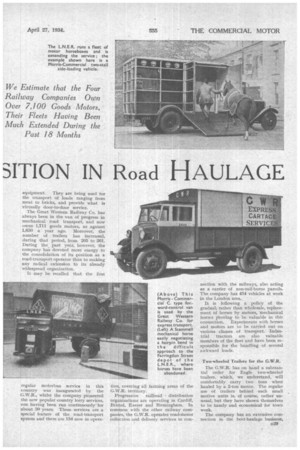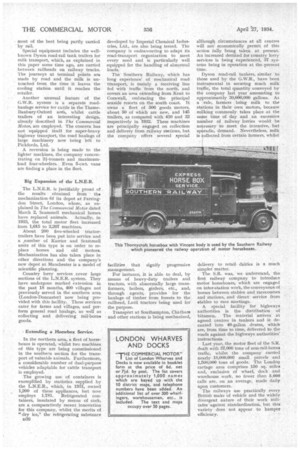THE RAILWAYS' Strong PC SIMON IN Road HAULAGE T HE past
Page 94

Page 95

Page 96

If you've noticed an error in this article please click here to report it so we can fix it.
year has seen a steady increase in the goods roadtransport activities of the four main-line railway companies, which are, iti fact, collectively the largest users of motor vehicles in Great Britain. The Great Western, .London, and North-Eastern and Southern Railway companies now own between them 4,890 motor 'vehicles and trailers.
Over 7,100 Railway Motors.
As the London Midland and Scottish Railway Company could not see its way to supply us with information for this review of recent progress in railway road-transport services, we are unable to give a precise, up-to-date
figure for this company's fleet. In 1932-33, however, the L.M.S. operated 1,952 road goods vehicles and, allowing a moderate figure for an increase in the fleet since that date, we estimate that the four great railways now own a total of well over 7,100 machines.
For purposes of comparison, it is interesting to reflect that the Minister of Transport forecast, in framing the Road and Rail Traffic Act, 1933, that D28 60,000 vehicles would require "
licences. Recently, however, Mr. W. E. Aston, a prominent member of the Road Haulage Association, has placed the figure at over 100,000. Even assuming the latter to be correct, the railways still own a noteworthy percentage of the total number. The most outstanding event in the realm of railway road transport, during the past. year, has been the purchase jointly by the four main-line companies Of the businesses of Carter, Paterson and Co., Ltd., and Pickfords. Ltd., and their subsidiaries, at a total cost of £2,180,000. The Carter, Paterson fleet exceeds 1,600 vehicles, whilst that of Pickfords is also extremely , large, so that it will readily be realized
• that the railways are directly interested in an enormous number of goods road vehicles.
Another important development is the wide adoption of mechanical horses by. all the four railway companies,. in order to replace animals.
This type of machine is, at present, the only mechanical unit that can fully perform the haulage functions of the horse, yet being also speedier and more efficient.
Containers of refrigerated and other types are figuring with increasing prominence. in railway road-transport equipment. They are being used for the transport of loads ranging from meat to bricks, and provide what is virtually door-to-door service.
The Great Western Railway Co. has always been in the van of progress in mechanical road transport, and now owns 1,711 goods motors, as against 1,630 a year ago. Moreover, the number of trailers has increased, during that period, from 205 to 261. During the past year, however, the company has devoted more energy to the consolidation of its position as a road-transport operator than to making any radical extension to its already widespread organization.
It may be recalled that the first
regular motorbus service in this country was inaugurated by the G.W.R., whilst the company pioneered the now popular country lorry services, one having been run continuously—for about 30 years. These services are a special feature of the road-transport system and there are 154 _now in opera lion, covering all farming areas of the G.W.R. territory.
Progressive railhead distribution organizations are operating in Cardiff, Bristol, Exeter and Birmingham. In common with the other railway companies, the G.W:R. operates road-motor collection and delivery services in con nection with the railways, also acting as a carrier of non-rail-borne parcels. The company has 434 vehicles at work in the London area.
It is following a policy of the gradual, rather than wholesale, replacement of horses by motors, mechanical horses proving to be valuable in this connection. Experiments with horses and motors are to be carried out on various classes of transport. Industrial tractors are also valuable members of the fleet and have been responsible for the handling of several awkward loads.
Two-wheeled Trailers for the G.W.R.
The G.W.R. has on hand a substantial order for Eagle two-wheeled trailers, which, we understand, will comfortably carry two tons when hauled by a 2-ton motor. The regular use of trailers behind such small motive units is, of course, rather unusual, but they have shown themselves to be handy and economical for town work.
The company has an extensive connection in the beet-haulage business, D29 most of the beet being partly carried by rail.
Special equipment includes the wellknown Dyson road-rail tank trailers for milk transport, which, as explained in this paper some time ago, are carried .between railheads on railway trucks. The journeys at terminal points are made by road and the milk is untouched from the time it leaves the cooling station until it reaches the retailer.
Another unusual feature of the G.W.R. system is a separate roadhaulage service for cattle in the ThameBanbury-Oxford area, Avhilst cattle trailers of an interesting design, already described in The Commercial Motor, are employed. The concern has not equipped itself for super-heavy highway transport, the road haulage of large machinery now being left to Pickfords. Ltd.
A reversion is being made to the lighter machines, the company concentrating on 2-tanners and maximumload four-wheelers. Even 5-cwt. vans are finding a place in the fleet.
Big Expansion of the L.N.E.R.
The L.N.E.R. is justifiably proud of the results obtained from the mechanization of its depot at Earringdon Street, London, where, as explained in The Commercial Motor dated March 2, Scammell mechanical horses have replaced animals. Actually, in 1933, the total motor fleet increased from 1,615 to 2,267 machines.
About 200 five-wheeled tractortrailers have been put into service and a ,number of Karrier and Scammell units of this type is on order to replace horses and old motors. Mechanization has also taken place in other directions and the company's new depot at Manchester is a model of scientific planning.
Country lorry services cover large sections of the L.N.E.R. system. They have undergone marked extension in the past 18 months, 400 villages not previously served in the southern area (London-Doncaster) now being provided with this facility. These services cater for farms and villages, and perform general road haulage, as well as collecting and delivering rail-borne goods.
Extending a Horsebox Service.
In the northern area, a fleet of horseboxes is operated, whilst two machines of this type are being commissioned in the southern section for the transport of valuable animals. Furthermore, a considerable number of dual-purpose vehicles adaptable for cattle transport is employed.
The growing use of containers is exemplified by statistics supplied by the L.N-E.R., which, in 1931, owned 1,200 of these appliances, hut now employs 1,781. Refrigerated containers, insulated by means of cork, are a comparatively recent innovation for this company, whilst the merits of "dry ice," the refrigerating substance
D30 developed by Imperial Chemical Industries, Ltd., are also being tested. The company is endeavouring to adapt its road-transport organization to meet every need and is particularly well equipped for the handling of abnormal loads.
The Southern Railway, which has long experience' of mechanical road transport, is mainly a receiving line fed with traffic from the north, and covers an area extending from Kent to Cornwall, embracing the principal seaside resorts on the south coast. It owns a fleet of 506 goods motors, about 50 of which are new, and 145 trailers, as compared with 430 and 32 respectively in 1932. These machines are principally engaged on collection and delivery from railway stations, but the company offers several special
facilities that signify progressive management.
For instance, it is able to deal, by means of heavy-duty trailers and tractors, with abnormally large transformers, boilers, girders, etc., and, through agents, provides for the haulage of timber from forests to the railhead, Latil tractors being used for the purpose.
Transport at Southampton, Chatha,in and other stations is being mechanized, although circumstances at all centres will not economically permit of this action fully being taken at present. An increased demand for country lorry services is being experienced, 37 systems being in operation at the present time.
Dyson road-rail tankers, similar to those used by the G.W.R., have been instrumental in securing much milk traffic, the total quantity conveyed by the company last year amounting to approximately 30,000,000 gallons. As a ride, farmers bring milk to the stations in their own motors, because milking commonly takes place at the same time of day and an excessive number of railway lorries would he n essary to meet the intensive, but sp radic, demand. Nevertheless, milk is ollected from certain farmers, whilst delivery to retail dairies is a much simpler matter.
The S.R. was, we understand, the first railway company to introduce motor horseboxes, which are engaged on inter-station work, the conveyance of horses between stables and racecourses and stations, and direct service from stables to race meetings.
A. special facility for highways authorities is the distribution of bitumen. The material arrives at agreed centres in tankers and is decanted into 40-gallon drums, which are, from time to time, delivered to the roads against the highways authorities' instructions.
Last year, the motor fleet of the S.R. dealt with 37,000 tons of non-rail-borne traffic, whilst the company carried nearly _18,000,000 small, parcels and 1,500,000 tons of goods. The London cartage area comprises 150 sq. miles and, exclusive of wharf, dock and warehouse work, no fewer than 5,000 calls are, on an average, made daily upon customers. The railways use practically every British make of vehicle and the widely divergent nature of their work milirates against standardizatibn, but this variety does not appear to hamper efficiency.




















































































































































































